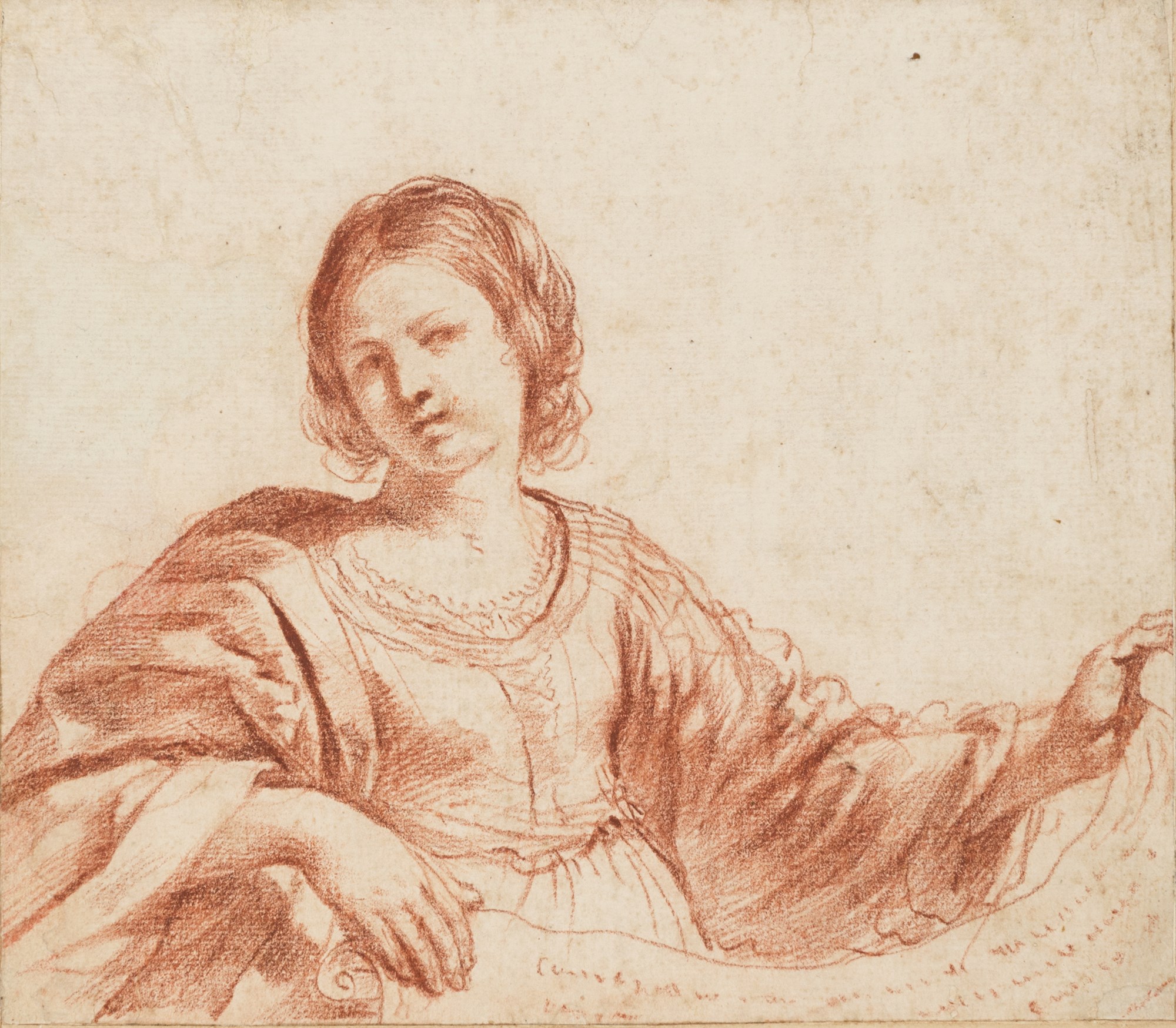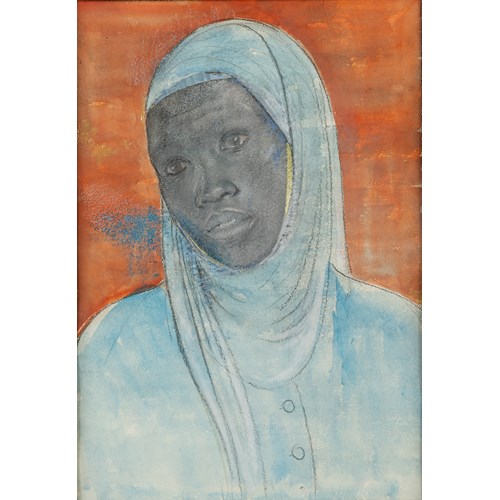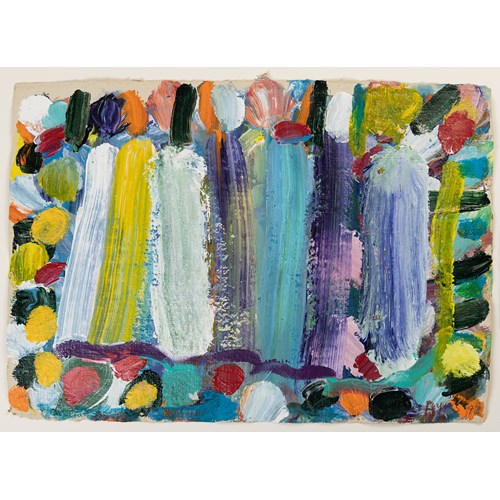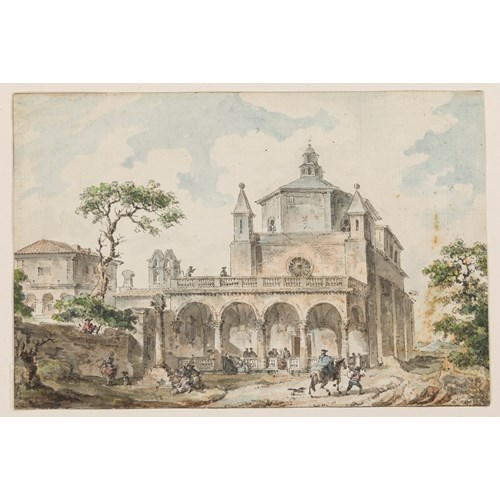Marketplace
A Sibyl
The twelve Sibyls of classical antiquity were pagan seers who are said to have foretold the coming of Christ, and thus were regarded as the secular and female equivalent of the prophets of the Old Testament. Guercino treated the theme of Sibyls in a number of paintings dating from throughout his career - notably depicting eight of them in the fresco decoration of four of the lunettes below the cupola of the Duomo in Piacenza between 1626 and 1627 - but the subject became especially common in his painted output of the 1640s and 1650s. These secular works proved particularly popular among collectors in Italy and, later, in England. As an early 19th century Irish art critic wrote of Guercino’s paintings of such female subjects, ‘His women, so highly admired by artists and amateurs, are not of celestial mould. They have neither the devotional calm of monastic seclusion, nor the studied elegance of Cleopatras. Made up of human sympathies, their charm is a blended character of delicacy and ardour, unaffected airs, the sparkling freshness of youth, and speaking expression of animated sensibility.’
Nicholas Turner has suggested that the present sheet may be related to a half-length painting of theSibyl Hellespontica, today in the collection of the National Trust at Ickworth House in Suffolk. (Sometimes also known as the Trojan Sibyl, the Hellespontine Sibyl was the priestess of the Oracle of Apollo at Dardania and is said to have predicted the crucifixion of Christ.) The painting is recorded as a work by Guercino when in the collection of Frederick Hervey, 1st Marquess of Bristol (1769-1859), and is noted as hanging in the library at Ickworth House in the 1830s. The composition is not known in any other version, and is not listed in Guercino’s Libro dei Conti. Until recently the painting was thought to be later in date and was attributed to Guercino’s nephew and pupil Benedetto Gennari the Younger. However, the high quality of the Ickworth canvas has led to a recent reassessment of it as, at least in part, an autograph work by the master, although its dating has remained something of a question mark.
Turner has compared the present sheet with two red chalk studies for the seated sibyls painted by Guercino in the Duomo in Piacenza in 1627, one in the Nasjonalgaleriet in Oslo and the other in the Szépmüvészeti Múzeum in Budapest. David Stone has, however, noted that the present sheet is more likely to be a later work of the first half of the 1630s. A comparison, on stylistic grounds, may be made with such red chalk drawings by Guercino as A Peasant Woman with a Basket of Grapes in the Uffizi in Florence, as well as two sheets at Windsor Castle; A Woman Showing a Nude Baby to Two Attendants and Saint Geneviève of Paris. Likewise similar in technique and handling is a drawing of The Virgin and Child in red chalk which appeared on the art market in 1998 and 2001.
A coarsely reworked counterproof of this drawing is in the Royal Collection at Windsor Castle, part of an extensive collection of nearly 240 offsets of red chalk drawings by Guercino acquired from the Casa Gennari in Bologna, in the late 1750s or early 1760s, by Richard Dalton for King George III. Although the dimensions of the Windsor counterproof are slightly larger than the present sheet, the scale is identical, and it would appear that this drawing has been trimmed slightly at the left and right edges. Another retouched counterproof at Windsor, of slightly larger dimensions, shows the same woman in an identical pose, but without the scroll and with much more sketchy outlines, and may record a lost initial sketch by Guercino for the present composition.
The album of counterproofs of Guercino drawings acquired by Dalton from the Gennari heirs in the 18th century contained offsets of original drawings by the master that were part of the contents of the artist’s studio in Bologna. While some of these counterproofs were pulled during Guercino’s lifetime, it would seem that most of them were done some time after his death, in order to preserve records of the original drawings before they were sold from the Casa Gennari. As Denis Mahon and Nicholas Turner have noted, ‘It is possible that the Windsor offsets were sold by Guercino’s heirs instead of the original red chalk drawings that they were either unwilling to sell to Richard Dalton or that he was unwilling to buy; he was apparently satisfied with the purchase of some of these ‘reproductions’ as supplements to the large group of autograph drawings he had already secured.’ It is likely, therefore, that the provenance of the present sheet can be traced back to the Casa Gennari.
Nicholas Turner has suggested that the present sheet may be related to a half-length painting of theSibyl Hellespontica, today in the collection of the National Trust at Ickworth House in Suffolk. (Sometimes also known as the Trojan Sibyl, the Hellespontine Sibyl was the priestess of the Oracle of Apollo at Dardania and is said to have predicted the crucifixion of Christ.) The painting is recorded as a work by Guercino when in the collection of Frederick Hervey, 1st Marquess of Bristol (1769-1859), and is noted as hanging in the library at Ickworth House in the 1830s. The composition is not known in any other version, and is not listed in Guercino’s Libro dei Conti. Until recently the painting was thought to be later in date and was attributed to Guercino’s nephew and pupil Benedetto Gennari the Younger. However, the high quality of the Ickworth canvas has led to a recent reassessment of it as, at least in part, an autograph work by the master, although its dating has remained something of a question mark.
Turner has compared the present sheet with two red chalk studies for the seated sibyls painted by Guercino in the Duomo in Piacenza in 1627, one in the Nasjonalgaleriet in Oslo and the other in the Szépmüvészeti Múzeum in Budapest. David Stone has, however, noted that the present sheet is more likely to be a later work of the first half of the 1630s. A comparison, on stylistic grounds, may be made with such red chalk drawings by Guercino as A Peasant Woman with a Basket of Grapes in the Uffizi in Florence, as well as two sheets at Windsor Castle; A Woman Showing a Nude Baby to Two Attendants and Saint Geneviève of Paris. Likewise similar in technique and handling is a drawing of The Virgin and Child in red chalk which appeared on the art market in 1998 and 2001.
A coarsely reworked counterproof of this drawing is in the Royal Collection at Windsor Castle, part of an extensive collection of nearly 240 offsets of red chalk drawings by Guercino acquired from the Casa Gennari in Bologna, in the late 1750s or early 1760s, by Richard Dalton for King George III. Although the dimensions of the Windsor counterproof are slightly larger than the present sheet, the scale is identical, and it would appear that this drawing has been trimmed slightly at the left and right edges. Another retouched counterproof at Windsor, of slightly larger dimensions, shows the same woman in an identical pose, but without the scroll and with much more sketchy outlines, and may record a lost initial sketch by Guercino for the present composition.
The album of counterproofs of Guercino drawings acquired by Dalton from the Gennari heirs in the 18th century contained offsets of original drawings by the master that were part of the contents of the artist’s studio in Bologna. While some of these counterproofs were pulled during Guercino’s lifetime, it would seem that most of them were done some time after his death, in order to preserve records of the original drawings before they were sold from the Casa Gennari. As Denis Mahon and Nicholas Turner have noted, ‘It is possible that the Windsor offsets were sold by Guercino’s heirs instead of the original red chalk drawings that they were either unwilling to sell to Richard Dalton or that he was unwilling to buy; he was apparently satisfied with the purchase of some of these ‘reproductions’ as supplements to the large group of autograph drawings he had already secured.’ It is likely, therefore, that the provenance of the present sheet can be traced back to the Casa Gennari.
Provenance: Probably by descent from the artist to his nephews, Benedetto and Cesare Gennari, the ‘Casa Gennari’, Bologna
Thence by descent to Carlo Gennari, Bologna, and probably sold in the second half of the 18th century
Anonymous sale, London, Rosebery’s, 4 June 2020, lot 109 (as Workshop of Guercino)
Private collection.
Plus d'œuvres d'art de la Galerie




_T638203653890241467.jpg?width=500&height=500&mode=pad&scale=both&qlt=90&format=jpg)




